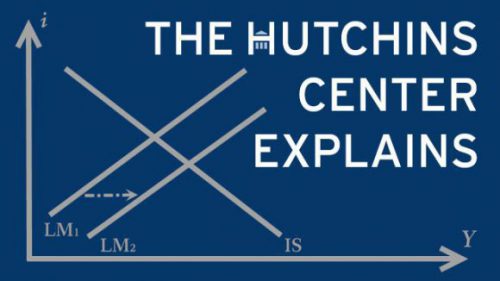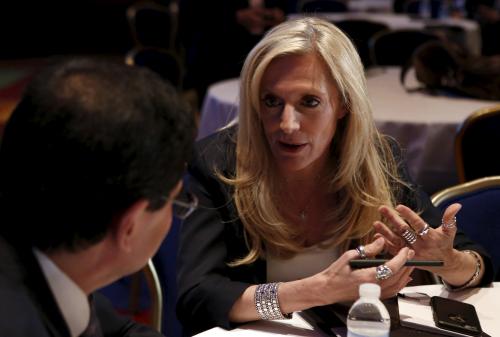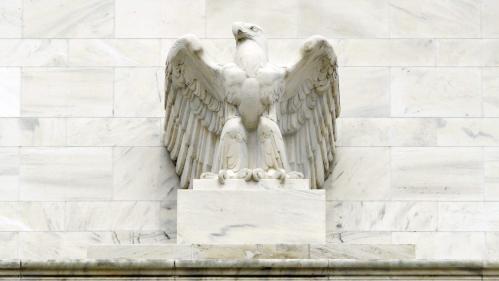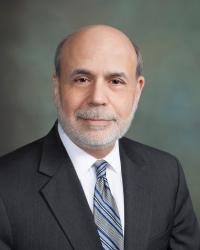To help stabilize the financial system and promote economic recovery, starting in late 2008 the Federal Reserve purchased large quantities of financial assets, primarily Treasury securities and U.S. government-backed, mortgage-related securities. The policy of so-called quantitative easing (see here and here) expanded the Fed’s balance sheet from less than $900 billion before the crisis to about $4.5 trillion today—including about $2.5 trillion in Treasuries and $1.8 trillion in mortgage-related securities.[1] The Fed stopped buying large quantities of assets in October 2014. Since then, it has kept the size of its balance sheet constant, buying just enough to replace maturing securities.
The FOMC has been clear that its current tightening campaign would ultimately involve shrinking the central bank’s balance sheet, but it has also said that will not begin that process until “normalization of the level of the federal funds rate is well under way.” In short: rate increases first, balance sheet reduction later.[2] However, recently, a number of Fed officials have begun talking about plans for shrinking the balance sheet, leading market participants and other observers to speculate that first steps in that direction may take place sooner than expected.[3]
Has the Fed’s approach to balance sheet normalization actually changed? At least until I hear otherwise from the FOMC’s leadership or the Committee as a whole, my guess (and hope) is that it hasn’t. As I’ll discuss in this post, the case for deferring action on the balance sheet until short-term rates are meaningfully higher remains at least as strong as it was when the FOMC’s strategy was first devised. I’ll make two main points:
First, policy communication will be made easier and the risk of market disruption minimized if the shrinkage of the balance sheet, once it begins, is passive and predictable. In particular, once the runoff of the Fed’s assets begins, the FOMC should proceed on the assumption that it will not be halted. But since the effect of balance sheet reduction on broader financial conditions is uncertain, it is prudent not to begin that process until short-term interest rates are comfortably away from their effective lower bound, leaving the Committee room to offset any unanticipated effects.
Second, before beginning to shrink the balance sheet, the FOMC should have a clearer idea of what its ultimate size should be. As I’ll explain, under reasonable scenarios only a moderate amount of balance sheet reduction may ultimately be needed, reducing any urgency to begin the unwinding process.
To be clear, in this post I am taking no position on the appropriate pace of overall monetary tightening. I’m arguing instead that, whatever pace of tightening the FOMC chooses, it’s best implemented in the near term by increasing the short-term interest rate. Although some shrinkage of the balance sheet will likely occur at some point, there’s no need to rush that process.
Shrinking the balance sheet: the case for keeping it simple
The Fed’s large-scale asset purchases were undertaken because, with interest rates nearly at zero, conventional interest-rate cuts wouldn’t suffice. However, as the FOMC recognized at the time, this relatively unfamiliar tool presented challenges, including the difficulty of estimating the effects of a given amount of asset purchases on near-term financial conditions. Predicting what market participants would infer about future policy from the Committee’s announcements about its asset-buying plans—the so-called signaling effect—was particularly challenging. When, as Fed chair, I indicated in testimony in 2013 that the FOMC was considering slowing asset purchases if economic conditions improved sufficiently, the markets responded with a “taper tantrum” that included sharp increases in volatility and a rise in longer-term rates. Much of this response came through the signaling channel, as some market participants inferred that slower asset purchases also implied a more-rapid increase in short-term interest rates. The taper tantrum calmed after FOMC members pushed back on that incorrect inference, emphasizing that short-term rates would remain low well after asset purchases were phased out.
To avoid similar disruptions during the eventual unwinding of the Fed’s balance sheet, the FOMC has been clear that it expects to reduce the balance sheet, when the time comes, in as passive and predictable a way as possible. Importantly, according to the FOMC’s most recent (September 2014) formal guidance, the balance sheet will ultimately be reduced, not by sales of assets that the Fed holds, but by ceasing or phasing out the Fed’s current practice of replacing or rolling over maturing assets (“reinvestment”).[4] By allowing the balance sheet to shrink passively over a number of years, without active selling, the FOMC aims to maximize predictability and minimize potential market disruption.[5]
In principle, avoiding asset sales would not necessarily preclude some active management of the balance sheet for policy purposes. For example, the FOMC could respond to evolving conditions by restarting reinvestment at some point, or it could vary the pace at which reinvestment is phased out. I worry though that, in practice, attempts to actively manage the unwinding process could lead to unexpectedly large responses in financial markets, particularly if market participants (as in the taper tantrum) were to take a strong signal about future rate policies from changes in the balance sheet’s trajectory. To minimize such risks, it seems more prudent, once the end of reinvestment is announced, to allow that process to continue without further management—that is, to simply allow the balance sheet to run down until it reaches the desired size, barring some major deterioration in the outlook. Indeed, in analyzing the effects of reducing the balance sheet at the September 2015 FOMC meeting, the Fed staff assumed, and appeared to advocate, precisely that: that once begun, the process of allowing excess assets to run off should not be reversed.
From a policy communications perspective, another reason to keep balance sheet policy simple and predictable is that it will help the public better interpret FOMC participants’ interest-rate projections. The degree of policy tightening implied by current interest-rate projections depends on what’s happening with the balance sheet; if the size of the balance sheet is not tied to rate policy in a relatively straightforward way, then inferring the stance of policy implied by a given set of rate projections will be difficult or impossible.[6] (FOMC participants could be asked to project the size of the balance sheet as well as future interest rates, but that would be very complicated and unlikely to be helpful.)
If it’s agreed that the most prudent approach to shrinking the balance sheet is simply, at some point, to stop reinvestment once and for all, then it also seems preferable to delay the beginning of that process until the short-term interest rate is well away from zero—a conclusion also drawn by the Fed staff. This is the basic logic for delaying balance sheet normalization until rate increases are “well under way.” If the end of reinvestment leads to more tightening of financial conditions than expected, or if the economy slows for some other reason, then being further away from the lower bound on interest rates would give the FOMC more scope to respond as needed.
How large should the Fed’s balance sheet be in the long run?
For reasons of transparency and predictability, when the FOMC announces the end of reinvestment it should also provide guidance about the ultimate size and composition of the balance sheet. That discussion appears still to be ongoing inside the Committee. As I noted here, there are reasonable arguments for keeping the Fed’s balance sheet large indefinitely, including improving the transmission of monetary policy to money markets, increasing the supply of safe short-term assets available to market participants, and improving the central bank’s ability to provide liquidity during a crisis. However, even if none of these arguments gains adherents on the FOMC, growing holdings of currency and changes in the Fed’s methods of implementing monetary policy alone may imply that only moderate reductions in the balance sheet will ultimately be required—another reason that it’s unnecessary to move quickly.
The growth in the public’s demand for currency is one (completely uncontroversial) reason that the Fed will need a larger balance sheet indefinitely. The minimalist central bank balance sheet, consistent with providing the public’s desired holdings of currency and nothing else, would include currency as the primary liability and government-issued securities as the primary asset. That’s a pretty good description of the Fed’s balance sheet before the crisis: liabilities were about $800 billion in currency in circulation, and assets (almost all in Treasuries) were only slightly greater than that. However, today currency in circulation has grown to $1.5 trillion. Because of rising nominal GDP, low interest rates, increased foreign demand for dollars and other factors, Fed staff estimates that, the amount of currency in circulation will grow to $2.5 trillion or more over the next decade.[7] In short, growth in the public’s demand for currency alone implies that the Fed will need a much larger balance sheet (in nominal terms) than it did before the crisis.
In addition to currency, the Fed now also has a large amount of short-term liabilities, primarily reserves held at the Fed by commercial banks and short-term assets of other counterparties, such as money market mutual funds. These liabilities were acquired in the process of the Fed’s asset purchases, as the bank accounts of those who sold assets to the Fed were credited; allowing assets to run off would extinguish those same liabilities. In large part, the question of how big the Fed’s balance sheet should ultimately be boils down to determining the Fed’s optimal level of bank reserves and other non-currency liabilities. A key issue in this regard is how the Fed plans to implement monetary policy in the future.
Prior to the crisis, the Fed set short-term interest rates through open-market operations that varied the quantity of bank reserves in the system, a technique which involved on average low levels of reserves—perhaps $10 billion or so. Today, the level of bank reserves is much higher, which makes it impossible to manage interest rates through small changes in the supply of reserves. Instead, the Fed manages short-term interest rates by setting certain key administered interest rates, such as the rate it pays bank on reserves held with the Fed. This “floor system” (called that because rates like the interest rate on bank reserves set a floor for the policy rate) was adopted out of necessity but seems to be gaining favor with the FOMC as a better way to manage monetary policy. According to the November 2016 minutes, FOMC participants described the current floor system as “relatively simple and efficient to administer, relatively straightforward to communicate, and effective in enabling interest rate control across a wide range of circumstances.”
What level of bank reserves would be needed for the Fed to continue to implement monetary policy by current methods? To ensure that the floor rate set by the central bank is always effective, the banking system must be saturated with reserves (that is, in the absence of the interest rate set and paid by the central bank, the market-determined return to reserves would be zero). In December 2008, when the federal funds rate first fell to zero and the Fed began to use the interest rate on bank reserves as a tool of monetary policy, bank reserves were about $800 billion. Taking into account growth in nominal GDP and bank liabilities, the critical level of bank reserves needed to implement monetary policy through a floor system seems likely to be well over $1 trillion today, and growing. Taking currency demand into account as well, it’s not unreasonable to argue that the optimal size of the Fed’s balance is currently greater than $2.5 trillion and may reach $4 trillion or more over the next decade. In a sense, the U.S. economy is “growing into” the Fed’s $4.5 trillion balance sheet, reducing the need for rapid shrinkage over the next few years.
Conclusion
At some point the Fed is likely to reduce the size of its balance sheet. Without taking a position on the overall pace of monetary tightening, I’ve offered two arguments why beginning that process is not urgent. First, to minimize the risk that unwinding the balance sheet will disrupt markets and the economy, the best approach is to allow a passive runoff of maturing assets, without attempting to vary the pace of rundown for policy purposes. However, even with such a cautious approach, the effects of initiating a reduction in the Fed’s balance sheet are uncertain. Accordingly, it would be prudent not to initiate that process until the short-term interest rate is safely away from the effective lower bound.
Second, to allow for appropriate guidance to the public and to markets, it would be wise for the FOMC to reach a consensus about the long-run optimal size of its balance sheet before starting the unwinding process. Even if some of the more exotic arguments for maintaining a large balance sheet are rejected, the FOMC may still ultimately agree that the optimal balance sheet need not be radically smaller than its current level. If so, then the process of shrinking the balance sheet need not be rapid or urgently begun.
Of course, if the Fed’s large balance sheet were actively harmful in some ways, these considerations could be overturned. There is however little evidence that, at current levels, the Fed’s balance sheet poses significant problems for market functioning or for the economy.
[1] Weekly data on the balance sheet are provided in the Fed’s H.4.1 release.
[2] According to the most recent survey of primary dealers by the Federal Reserve Bank of New York, the median dealer expected the FOMC to allow the balance sheet to begin shrinking in mid-2018.
[3] Some FOMC members, such as Governor Brainard and San Francisco Fed President Williams, have cautiously mentioned the possibility of ending reinvestments (or starting to discuss a timetable) in the context of discussing potential fiscal stimulus and other upside risks to the outlook. Others, such as Reserve Bank Presidents Kaplan and Bullard, have been more direct. President Harker has been the most explicit about sequencing (see here and here), suggesting a funds rate target at 1 percent (100 basis points) as a benchmark for “serious consideration” of stopping reinvestment in the Fed’s maturing securities. President Rosengren previously raised the possibility of using asset sales to affect the slope of the Treasury yield curve.
[4] Anticipating current FOMC statements, the guidance also specifies that the end of reinvestments would begin after the Committee begins increasing the federal funds rate, with the timing “depend[ing] on how economic and financial conditions and the economic outlook evolve.”
[5] Normalization of the balance sheet involves not only reducing its overall size but also, according to FOMC guidance, eliminating holdings of most mortgage-related securities in favor of Treasuries. At some point, therefore, the Fed may actually have to begin buying Treasuries again, to replace maturing mortgage securities. The Fed will also need to make purchases (of Treasury bills, for example) to achieve its desired mix of short-term and long-term assets.
[6] According to Janet Yellen in a recent speech (see footnote 17), the effects of the balance sheet are significant. She reports that, according to staff calculations, the simple fact that the date of ending reinvestment is drawing nearer is worth the equivalent of two additional quarter-point rate hikes in 2017.
[7] Specifically, the staff estimates that the modal level of the balance sheet in 2025 will be $2.7 trillion, assuming that almost all the Fed’s liabilities are in the form of currency.
Comments are now closed for this post.







Commentary
Shrinking the Fed’s balance sheet
January 26, 2017